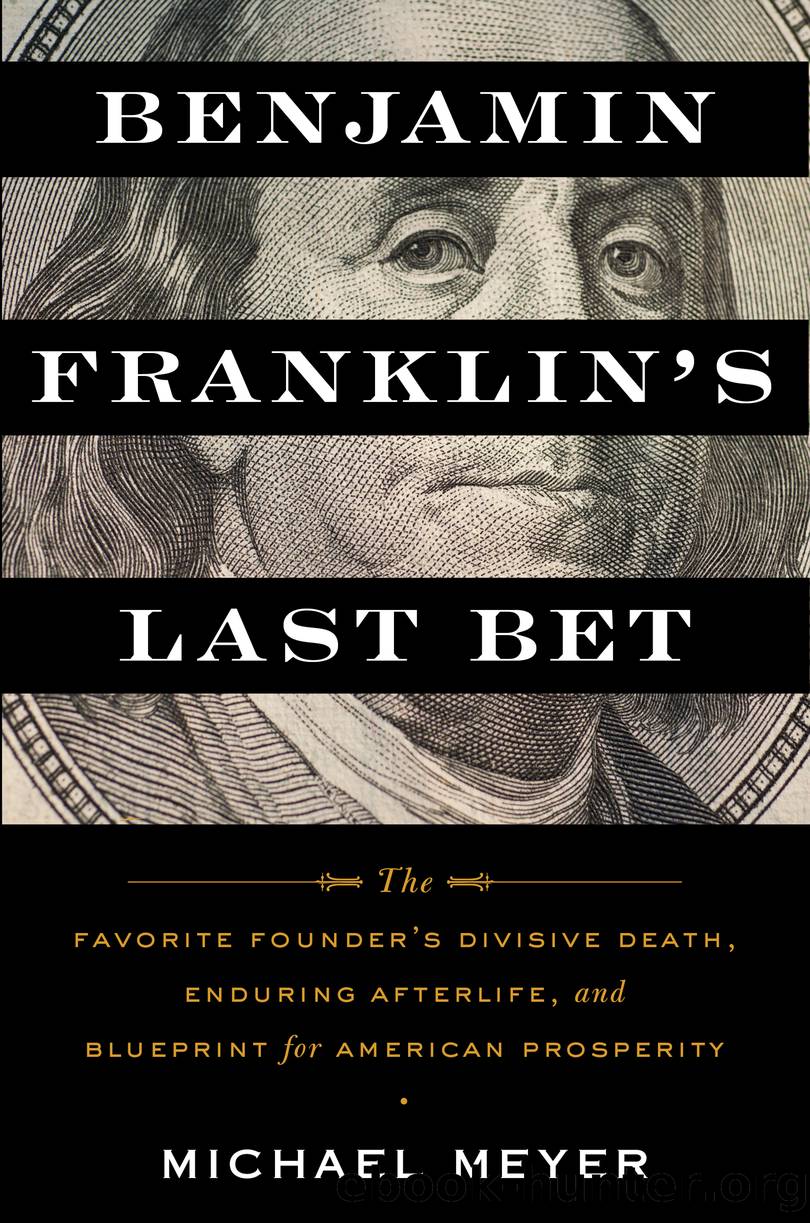Benjamin Franklin's Last Bet by Michael Meyer

Author:Michael Meyer
Language: eng
Format: epub
Publisher: HarperCollins
Published: 2022-02-10T00:00:00+00:00
Philadelphia even let its benefactorâs final resting place sink into obscurity. âSo well hidden is this grave,â one newspaper reported in 1853, âand so little frequented, that we have known many native Philadelphians . . . who could not direct one to the locality where it may be found.â Franklin and his family remained interred in the Christ Church Burial Ground, in the heart of central Philadelphia.
The story was reprinted across the country. At a Boston town meeting, Robert Charles Winthrop, former Speaker of the U.S. House of Representatives, read the outrage aloud. Winthrop compared Franklinâs grave to that of Archimedes, which Cicero finally found, overgrown with brush, in Syracuse, 137 years after the mathematicianâs death. Philadelphians, Winthrop taunted, had forgotten Benjamin Franklin in less than half that time. He urged Bostonians to reclaim Franklin as their own. It would be Winthrop who, capping the public holidayâs festivities in 1856, unveiled Bostonâs bronze likeness of him.
But then, what was a statue compared with Franklinâs actual remains? After the publicity generated by Bostonâs celebration, a trickle of pilgrims carried stools to peer over Philadelphiaâs Christ Church cemetery wall. One elderly minister, upon finding the gates locked, borrowed a ladder from a nearby store and scaled the barrier. âThe grave of Franklin was discovered,â a newspaper reported, âand kneeling upon the sod, the ardent admirer of the dead philosopher spent an hour in rapt meditation upon his heroâs life and character.â Only then did the minister realize that he was trapped. The shopkeeper had recovered his ladder. The minister managed to scale the wall, then perch on top in his long black coat and white clerical cravat, considering the way down.
A procession of passing Quaker Friends stopped to ask if he was insane. ââInsane!ââ the preacher thundered. âThen he was to be regarded as a madman for his devotion to Franklin! He stretched forth his hand, concentrated upon himself all eyes, and then â astride the wall as he was â commenced an eloquent address upon the neglect of Franklinâs memory. His success upon this occasion was triumphant. From the accused he had become the accuser. A ladder was brought him, and ceasing his oration, he descended from his perch. He was greeted as he reached the ground by hearty applause, and retired followed by an ovation.â
Readers wrote to Philadelphiaâs newspapers, suggesting that the cemetery gate remain unlocked. Another letter proposed inserting âa railed aperture in the wall opposite the grave, in order that the universally felt and laudable desire of strangers and citizens to view the resting-place of the statesman, philanthropist, and sage, may be gratified.â
If that proposal sounded technically specific, it was because staff at the Franklin Institute had submitted it, unsigned, hoping to gather support for their idea.
The next year, in 1858, America celebrated the laying of the first transatlantic telegraph cable. Philadelphia held a parade, and speeches connected Franklinâs charged kite string to the ribbon of wire pulsing with electrical bursts sent between Europe and North America.
That autumn,
Download
This site does not store any files on its server. We only index and link to content provided by other sites. Please contact the content providers to delete copyright contents if any and email us, we'll remove relevant links or contents immediately.
Cecilia; Or, Memoirs of an Heiress — Volume 1 by Fanny Burney(32440)
Cecilia; Or, Memoirs of an Heiress — Volume 2 by Fanny Burney(31875)
Cecilia; Or, Memoirs of an Heiress — Volume 3 by Fanny Burney(31858)
The Great Music City by Andrea Baker(31539)
We're Going to Need More Wine by Gabrielle Union(18973)
All the Missing Girls by Megan Miranda(15597)
Pimp by Iceberg Slim(14399)
Bombshells: Glamour Girls of a Lifetime by Sullivan Steve(13979)
Talking to Strangers by Malcolm Gladwell(13233)
Norse Mythology by Gaiman Neil(13216)
Fifty Shades Freed by E L James(13163)
For the Love of Europe by Rick Steves(13116)
Mindhunter: Inside the FBI's Elite Serial Crime Unit by John E. Douglas & Mark Olshaker(9209)
Crazy Rich Asians by Kevin Kwan(9173)
The Lost Art of Listening by Michael P. Nichols(7412)
Enlightenment Now: The Case for Reason, Science, Humanism, and Progress by Steven Pinker(7242)
The Four Agreements by Don Miguel Ruiz(6640)
Bad Blood by John Carreyrou(6558)
Weapons of Math Destruction by Cathy O'Neil(6152)
